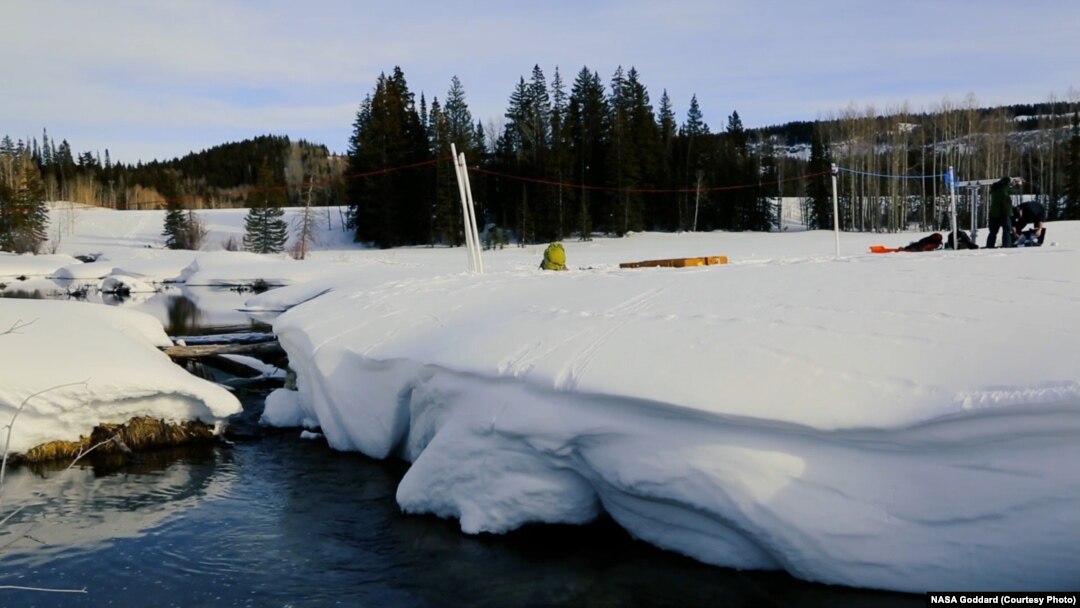In dry northern regions, the melting from winter snowpack is crucial for filling reservoirs, irrigating crops and providing drinking water.
In northern Colorado, communities get 80 percent of their water from snowpack, so knowing the water content of snow helps them plan ahead.
But, unlike other weather data about rainfall and storms -- gathered from orbiting satellites -- the dazzling, reflective nature of snow makes it hard to measure the depth of a snowpack from space. In fact, NASA weather scientists report that currently, worldwide estimates of the water stored in snow may be off by 30 to 50 percent.
So NASA is launching an ambitious project to create a new “snow satellite.”
Your browser doesn’t support HTML5
NASA Plans to Measure Snowpack From Space
Ground measurements
The traditional way to measure snow depth and water content involves shovels. U.S. Forest Service scientist Frank McCormick says researchers tromp through the snow to selected areas, then do some serious digging.

To measure snowpacks, researchers dig snowpits down to bare ground.
“They’ll dig a snow pit down to bare ground so that they can take very detailed measurements — everything from temperature to water that’s in the snow," he said.
Mountain snowpack can be so heavy, snow pits can be more than five meters deep. After they’re completed, scientists take careful measurements that accurately reveal that location’s snowpack levels and water content.
But on a global scale, McCormick says, digging snow pits isn’t practical, noting, “We would need thousands upon thousands upon thousands of sites throughout the world.”
Measurements from space
That’s why NASA launched “SnowEx,” a five-year project to design a satellite that will accurately measure snowpack while orbiting the earth. This means the satellite will someday measure snowpack everywhere.
When deployed, the SnowEx satellite will be able to measure snowpack depth and water content, even through trees.
SnowEx Project Leader Edward Kim says knowing snowpack’s water content, when it’s likely to melt and so on, could help over a billion people. “[For] one out of every six people in the world," he points out, "the majority of their water, that they use for drinking and agriculture and industry, comes from snow.”
To design the satellite, 100 SnowEx scientists are teaming up to figure out the best ways to remotely measure snowpack’s depth, its water content, how surface dust and temperature affect snow, and more. As a first step, they’re putting snow sensors above the earth — though not as high as a satellite, yet.
At busy, noisy Peterson Air Force Base in Colorado Springs, Kim points over his shoulder at a big propeller plane. The plane has an unusual bumpy nose and pointy tale. He says that's because the plane is equipped for measuring snow.
“The airplanes carry the sensors of the same type that would eventually be on a satellite,” he said.
Inside the plane, half a dozen scientists are fine-tuning 10 kinds of weather sensors, including microwave and laser. They stay on board, monitoring their instruments, as pilots fly over pre-selected snowy mountains, and high, snowy mesas. They’re seeking accurate snow measurements, even when craggy peaks mean snow is at different levels in the peaks and the valleys. Even when trees and forests hide the snow.
Get the data
To fine-tune their airborne measurements, the SnowEx team will compare them with traditional snow pit data. SnowEx scientist Charles Gatabe says fitting it all together will require complex calculations, but at its hearts, the goal is simple: Get the data, look at the data, and say what the data is telling us.
Researchers currently gather snow data the old-fashioned way - in the field.
“There’s so many people dependent on snow,” he stresses, adding, “and given this changing climate, who knows what happens? So if we can get a very good handle how to predict, you know, the changing snow, and the changing climate, I think it’s going to benefit a lot of people.”
NASA’s SnowEx team plans to use this data from this five-year project to make better predictions about snowpack around the world, including someday through a snow satellite. And they share their data in open access, to help people around the world, wherever there is snow.


